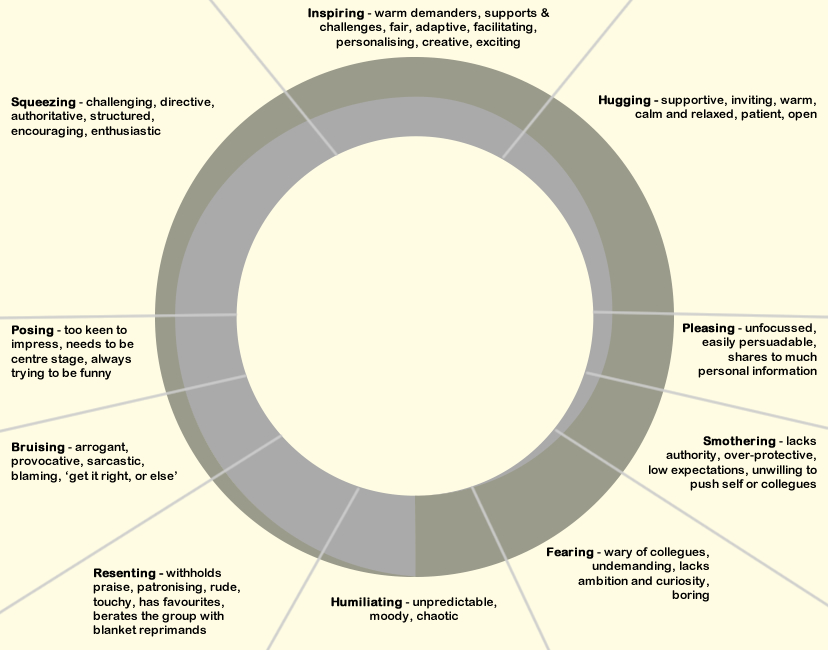The Leader Profile
The Leader Profile is a reflection tool, not an assessment or a test. It consists of a set of descriptions that enable us to profile our Leadership Style. It invites us to rate each description on how well they describe ourselves on a six point scale. Highly rated descriptions are then displayed on a personal chart. The chart allows a structured and focused discussion of our key strengths and issues. The chart helps us to make sense of how we feel about ourselves in the context of our current team. The process lets us express what we know intuitively about ourselves but might struggle to put into words. The Leader Profile gives four pieces of information:
- overall inspiration score from 0 to 100%
- your balance between fair to self and fair to others e.g. 60% to 40%
- a % score for each of the leadership styles
- our specific strengths and issues
By inviting colleagues to complete a profile of our leadership, we can access their views of our leadership style. A whole team profile can be collated through the assembly tool. See resources for more information.
Asking colleagues for their opinions on our leadership is a powerful demonstration of our respect. It also develops their autonomy and builds their understanding of the team dynamics. Responding to feedback is a key driver for promoting a positive climate. In any effective partnership, both parties must be able to raise issues concerning the quality of the relationship. Colleagues’ views offer a necessary counter balance to any bias inherent in our own perceptions.
The Leader Profile is designed to help us better understand our impact on our team and the team’s impact on us. We make sense of ourselves and others through “rules of thumb”. The model offers a more objective heuristic, with a new perspective on ourselves, comparing our ‘good day’ and ‘bad day’ styles. The framework helps us to see how we change as we adapt from one situation to another.
The most important capacity we can have to get the best from ourselves and others is an understanding of the processes of our selfhood, as the source of aspiration. The front sheet of the chart summarises the inter-relationship between the four processes of 'selfhood', namely personality, motives, emotions and identity and provides a language for exploring our inner life. The array of questions gives the profile a degree of impartiality. The second sheet is a personalised chart that lends itself to conversations to discuss our self-perceptions in a non-judgemental way. Ideally we should share findings with someone we trust.
More than anything else, we aspire to determine our own fate. Autonomy lies at the heart of the model. The model illuminates a new way to think about autonomy, with two distinct motives, namely Personal Autonomy - getting ahead, and Shared Autonomy - getting along, the two main ways we can be significant within our team. These are represented by two spirals that together form the Ring of Autonomy. When one spiral balances the other we have balanced Autonomy. This allows us to resolve the inherent tensions between cooperation and competition.
Personal Autonomy is our need to assert our individuality and achieve status. It generates self-determination and propels us to maximise our strengths and personal achievement. Personal Autonomy is grounded in and, in turn, further develops Agency, a sense of competence.
Social Autonomy is our need to contribute to something bigger than ourselves and have a sense of shared purpose. It generates cooperation and shared goals. Social Autonomy grows naturally out of Affiliation, a sense of belonging.
There are two potential pitfalls with Autonomy, when the spirals becomes imbalanced, with one strand dominating. These form the underside of the Ring. It allows us to see how Personal Autonomy can slide into Corrupted Autonomy, where we use others for our own ends. The dark side to Social Autonomy is when we over-accommodate to others, leading to acquiescence or Surrendered Autonomy.

We each tend to have our own preferred Autonomy motive; we lean either towards Social or Personal Autonomy. Our position on the ring represents how we resolve the tension between being fair to self and being fair to others.
The Leader Profile helps leaders to reflect on how they balance Support and Challenge. After completing the profile, a leader's point on the ring represents how she or he resolves the tension between Support and Challenge. Each leader's resolution can be adaptive or can become imbalanced in one of two directions, either towards being 'over-demanding' or 'over-protecting', as displayed in Fig 2 below.

This ring is sub-divided into sections to form Leadership Styles, as displayed in Fig 3 below. They are temporary states rather than fixed (dis)positions. We can get a new perspective on ourselves by reflecting on the Ring, comparing our ‘good day’ and ‘bad day’ styles. The styles offer a common language for us to discuss with colleagues our impact in a de-personalised way.
